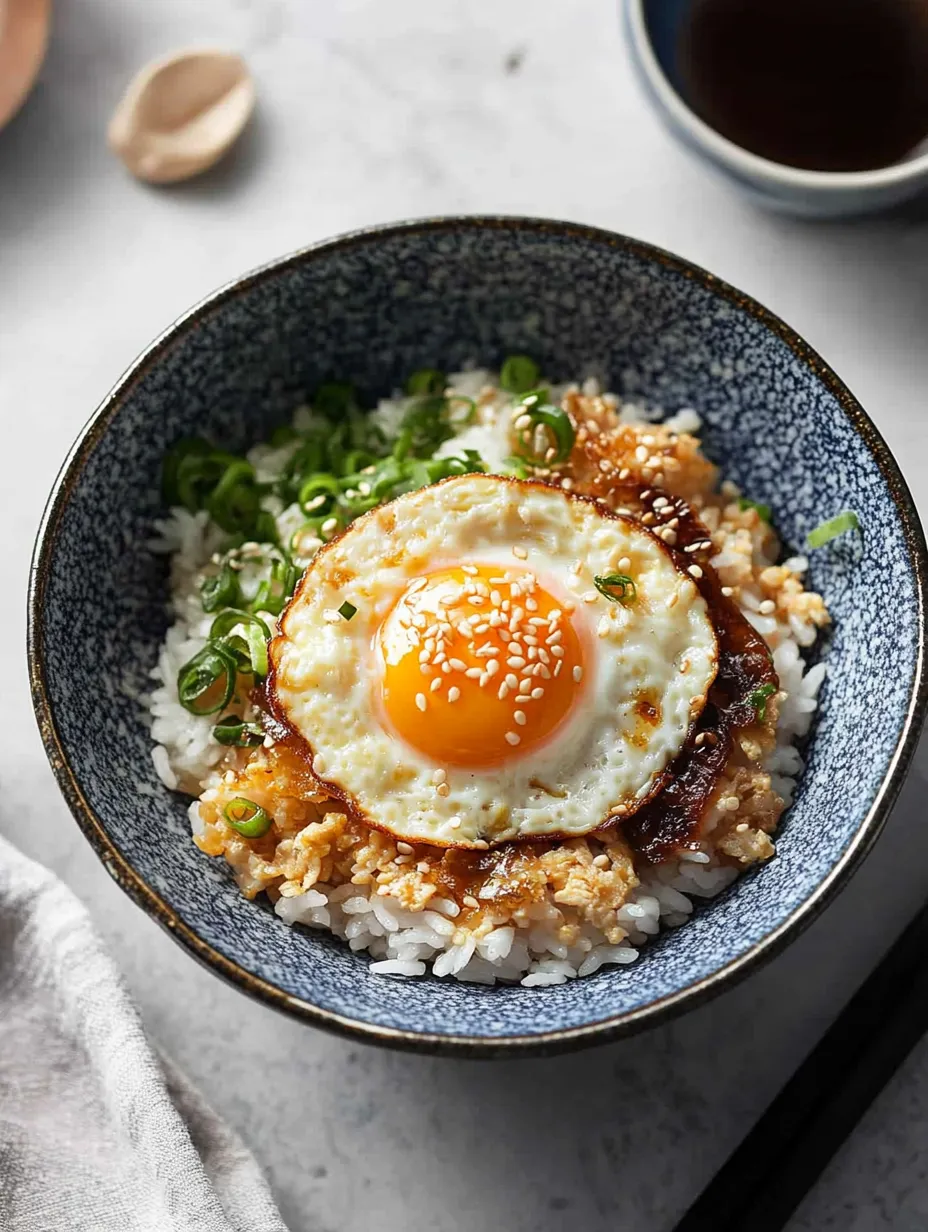 Pin it
Pin it
This hearty 10-minute Korean egg rice (Gyeran Bap) offers the perfect combination of comfort and simplicity. Known as a staple in Korean households, this versatile dish transforms basic ingredients into a satisfying meal that works any time of day.
I first made this during a particularly busy workweek when I needed something quick yet satisfying. The way the runny egg yolk creates a silky sauce when mixed with the hot rice converted me instantly. Now it's my go-to comfort meal when time is short but I still want something homemade.
Ingredients
- Short grain rice: Forms the foundation of this dish, providing the perfect sticky texture that captures all the flavors; traditional in Korean cooking but jasmine rice works well too
- Egg: Creates richness and protein; when the yolk breaks into the rice, it forms a natural creamy sauce
- Butter: Adds luxurious richness that transforms plain rice into something special; use high-quality butter if possible
- Sesame oil: Brings nutty, aromatic depth that defines Korean cuisine; always use toasted variety for maximum flavor
- Soy sauce: Provides savory umami balance; look for naturally brewed varieties for the best flavor profile
- Sesame seeds: Contribute texture and visual appeal; toast them first to enhance their nutty flavor
- Green onions: Offer fresh brightness and color contrast; choose ones with firm stems and vibrant green tops
Step-by-Step Instructions
- Prepare the rice:
- Combine hot cooked rice with butter in a bowl, stirring thoroughly until the butter melts completely and coats every grain. This step is crucial as it creates the rich foundation for your dish. The warmth of the rice should melt the butter without any additional heating needed. Transfer to a serving bowl where the sides will help contain all your toppings.
- Cook the perfect egg:
- Heat a nonstick pan over medium heat with just enough oil to thinly coat the surface. Crack your egg directly into the pan, being careful not to break the yolk. Allow the whites to set until they become opaque and just firm around the edges while keeping the yolk runny. For faster cooking without burning the edges, spoon some of the hot oil over the yolk. This technique ensures even cooking while maintaining that desirable runny center.
- Assemble your bowl:
- Place your perfectly cooked egg directly on top of the buttered rice, creating an appealing presentation. The egg should be centered on the rice mound so that when you break the yolk it will distribute evenly throughout the dish. The visual contrast between the white egg and the rice creates an appetizing appearance.
- Season and garnish:
- Drizzle sesame oil around the perimeter of the bowl, letting it run down into the rice. Sprinkle sesame seeds evenly across the surface. Add finely sliced green onions for color and freshness. Finally, pour soy sauce over the egg, allowing it to penetrate the rice below. The amount of each seasoning can be adjusted to your personal taste preferences.
- Mix and enjoy:
- Break the egg yolk and mix everything together thoroughly. The runny yolk will combine with the soy sauce, butter, and sesame oil, creating a rich, savory sauce that coats every grain of rice. Make sure to scrape the sides and bottom of the bowl to incorporate all the seasonings evenly.
 Pin it
Pin it
The toasted sesame oil is truly the magic ingredient in this dish. I discovered its importance when I once made this recipe without it and found the flavor significantly lacking. The aromatic nuttiness it provides cannot be replicated and reminds me of my grandmother's kitchen where the scent of sesame oil always signaled something delicious was coming.
Cultural Significance
Gyeran Bap holds a special place in Korean food culture as an everyday comfort food. Historically, this dish emerged as a practical way to create a satisfying meal with minimal ingredients during times when resources were limited. In Korean households, it's often prepared as a quick meal for children after school or as a late-night snack. The combination of rice and egg has long been valued for providing energy and sustenance in a simple format. Today, it remains popular not just for its convenience but because it offers genuine comfort through familiar flavors and textures.
Perfect Variations
While the basic recipe is delicious on its own, Korean egg rice welcomes numerous additions that can transform it into an entirely different experience. Kimchi adds spicy tanginess and probiotics, while canned tuna provides additional protein and savory depth. Roasted seaweed flakes, known as gim, contribute oceanic flavor and essential minerals. For a more substantial meal, add diced avocado for creamy richness or sautéed vegetables like carrots, spinach, or zucchini for nutrition and color. These variations allow you to adapt the recipe based on what you have available, making it an excellent vehicle for using leftovers creatively.
 Pin it
Pin it
Storage Tips
Prepared Korean egg rice is best enjoyed immediately while the egg is still warm and the textures are at their peak. However, if you need to store leftovers, separate the components whenever possible. Keep cooked rice refrigerated in an airtight container for up to three days. When reheating, add a sprinkle of water before microwaving to restore moisture. For meal prep purposes, prepare the rice and toppings separately, storing the sliced green onions in a paper towel-lined container to maintain freshness. Cook the egg fresh just before serving for the best experience as reheated eggs tend to become rubbery.
Frequently Asked Questions
- → How do I cook short-grain rice?
Rinse the rice under cold water until the water runs clear. Use a rice cooker or stovetop by soaking the rice for 20-30 minutes and cooking with water until it's fully absorbed. Fluff and serve.
- → Can I use other types of rice?
Yes, you can substitute short-grain rice with jasmine rice or other varieties, but the texture and flavor might differ slightly.
- → What are some recommended toppings?
Try additions like kimchi, avocado, roasted seaweed flakes, canned tuna, or sautéed vegetables for extra flavor and nutrition.
- → How do I make crispy-edged eggs?
Use a generous amount of oil and fry your eggs over medium heat until the edges become crispy and golden brown.
- → Can I make this dish vegetarian?
Yes, substitute butter with plant-based alternatives and ensure your soy sauce is vegan-friendly. Add veggies like sautéed spinach or zucchini for more flavor.
